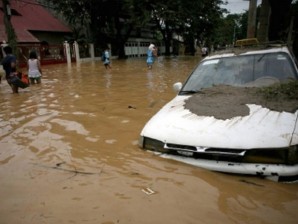Marikina watershed reforestation pushed

Residents evacuate themselves and their belongings from their houses inside Provident Village in Marikina City as Typhoon Ondoy brought heavy rains in Metro Manila on Sept. 26, 2009. INQUIRER FILE PHOTO
Two years after Tropical Storm “Ondoy” struck, the victims of its most devastating wrath, heaped on Marikina City, remained inundated with promises—and no action—that never again would they ever be placed at such horrific risk.
Marikina Representative Romero Federico Quimbo said that while officials of the Aquino administration had talked about addressing the problem, no major flood control project had yet been thought of or was on the drawing board.
On Sept. 26, 2009, Ondoy dumped in Metro Manila a record 341 millimeters of rain in six hours—almost equivalent to the amount of drenching the capital used to get this month, triggering floods and killing nearly 500 people. The worst hit area was Marikina.
On the second anniversary of the storm’s deadly sweep, the Department of Environment and Natural Resources (DENR) repeated prescriptions that officials in the previous Arroyo administration had enunciated, among them the reforestation of the Marikina watershed.
Environment Secretary Ramon Paje and seven mayors in surrounding areas on Monday signed a “statement of commitment” declaring the Marikina watershed an area to be protected from land-grabbers, both residential developers and commercial establishments.
Article continues after this advertisementThe group promised to plant 5 million seedlings over 10,000 hectares of the watershed from this year up to 2016, the end of President Benigno Aquino III’s term.
Article continues after this advertisement“We hope to complete the required documentation so we could forward the proposed proclamation to the Office of the President,” Paje said.
Another Ondoy feared
But Quimbo said that to make the watershed effective in preventing floods, at least 25 million trees had to be replanted. He said that almost 80 percent of the 28,000-hectare watershed had been denuded.
He said it would take at least 10 years to replant the area.
“In the meantime, the city is at the mercy of nature. With global warming taking its full toll, we continue to worry that more rains will be forthcoming in the next two years,” Quimbo said in a statement Monday.
“We cannot wait that long. We fear another Ondoy happening unless immediate and comprehensive flood mitigation programs are implemented along the river.”
Quimbo also explored the possibility of putting up a dam in the town of Rodriguez (formerly Montalban) as the quickest solution.
“Owing to the siltation of the Marikina River, particularly that brought down by Ondoy two years ago, the river’s containment capacity is down by 60 percent from eight years years ago,” he said.
Water impounding
Quimbo stressed that a dam located upriver would contain the rain water for a few hours instead of immediately bringing it down to the Marikina River system.
The dam can also be a source of energy which the country needs in the next three years anyway, he said.
Based on the reports of the Department of Energy (DOE), the country will have critical levels of power by 2014.
Other intermediate steps that needed to be immediately funded are water impounding areas in Antipolo City, and slope and embankment protection along the Marikina River, Quimbo said.
The lawmaker recognized efforts to rehabilitate some of the flood control infrastructure, pointing to initiatives at the Nangka River system and at least two major creeks in his district.
He called for a more comprehensive plan to address flooding in Marikina that will also involve its surrounding cities and municipalities, especially Antipolo, Pasig, San Mateo and Rodriguez.
Ninety percent of the floodwater that Marikina catches comes from Antipolo and Rodriguez, he said.
“Whatever due diligence Mariqueños do in terms of waste segregation, cleanup and rehab of our drainage and creek system, if our neighbors do not cooperate, we will continue to suffer,” Quimbo said.
“Water rises so fast and with less rain than it used to. Now, heavy rains that last two hours already swell the river. It used to take at least six to seven hours of continuous rain for that to happen,” he said.
First line of defense
In elaborate ceremonies marking Ondoy’s onslaught, Marikina Mayor Del de Guzman vowed to make the watershed reforestation his priority.
“It is called Marikina watershed because it is ours. And the responsibilities to take care of it and protect it lie with us,” De Guzman said during a fluvial and foot parade on a stretch of the river.
“This is our first line of defense. When this is gone, all the floodwater will go toward Marikina,” the mayor said.
After the parade, a Mass was held at Provident Villages, one of the hardest hit by Ondoy where most houses were submerged in 7-meter deep floodwaters and at least 11 people died.
The Mass was attended by the survivors of Ondoy and members of the Save the Sierra Madre Network, including its cofounder, former Isabela Governor Grace Padaca.
Fr. Pete Montallana, head of the network, said that moving forward for the victims should mean taking care of their environment and learning from the lessons the flood taught them.
“We should not forget the wake-up call for us two years ago,” he said. With reports from Kristine L. Alave and Niña Calleja